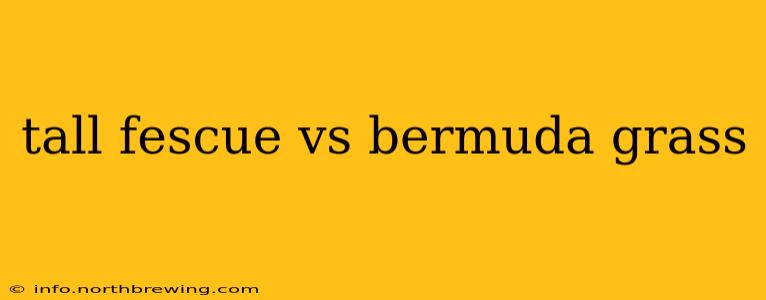Choosing between tall fescue and Bermuda grass for your lawn can feel overwhelming. Both are popular choices, but their characteristics differ significantly, making one a better fit for some climates and lifestyles than the other. This comprehensive guide will break down the key differences to help you make an informed decision.
What is Tall Fescue?
Tall fescue is a cool-season grass thriving in cooler climates with average temperatures between 60-75°F (15-24°C). It boasts excellent shade tolerance, making it an ideal choice for lawns with limited sunlight. Its deep root system contributes to drought tolerance once established. However, it doesn't fare well in intense heat and humidity. Tall fescue's coarse texture and dark green color give it a lush appearance. Maintenance is relatively low compared to some other grass types, requiring less frequent mowing.
What is Bermuda Grass?
Bermuda grass is a warm-season grass flourishing in hot, sunny climates with temperatures above 80°F (27°C). It loves full sun and tolerates heat and drought exceptionally well, making it a popular choice in southern regions of the United States. Its fine texture and light green color create a more refined look. While remarkably resilient, Bermuda grass requires more frequent mowing and fertilization than tall fescue. It can also be more challenging to manage in shady areas.
Tall Fescue vs. Bermuda Grass: A Head-to-Head Comparison
| Feature | Tall Fescue | Bermuda Grass |
|---|---|---|
| Climate | Cool-season (60-75°F optimal) | Warm-season (80°F+ optimal) |
| Sun Tolerance | Tolerates shade well | Requires full sun |
| Drought Tolerance | Moderate (once established) | Excellent |
| Heat Tolerance | Poor | Excellent |
| Foot Traffic | Moderate tolerance | High tolerance |
| Texture | Coarse | Fine |
| Color | Dark green | Light green |
| Maintenance | Relatively low | Relatively high |
| Cost | Generally less expensive to establish | Can be more expensive to establish |
Which grass is better for shade?
Tall fescue significantly outperforms Bermuda grass in shady conditions. Bermuda grass requires ample sunlight for optimal growth, while tall fescue thrives even with partial shade.
Which grass needs less water?
While both grasses can develop drought tolerance, Bermuda grass generally requires less supplemental watering once established due to its deeper root system.
Which grass is better for high-traffic areas?
Bermuda grass is the superior choice for high-traffic areas due to its resilience and ability to recover quickly from wear and tear. Tall fescue can handle moderate traffic, but heavy foot traffic can damage it more easily.
Which grass is easier to maintain?
Tall fescue generally requires less maintenance in terms of mowing frequency and fertilization. Bermuda grass, while hardy, needs more frequent mowing and fertilization to maintain its lush appearance.
Which grass is best for a North vs. South climate?
Tall fescue is ideal for northern climates with cooler temperatures, while Bermuda grass excels in southern regions with hot and sunny conditions. Choosing a grass type suited to your climate will ensure optimal growth and minimize maintenance challenges.
Is one type cheaper than the other?
Typically, establishing tall fescue is less expensive than establishing Bermuda grass. However, the long-term maintenance costs can vary depending on your location, climate, and maintenance practices.
By carefully considering these factors and the specific conditions of your lawn, you can choose the grass type that best meets your needs and ensures a beautiful, healthy lawn for years to come. Remember to consult with local lawn care professionals for region-specific advice.
